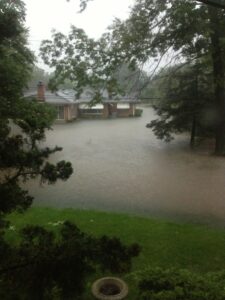Floodplain Engineering
Serving public and private clients in Illinois, Indiana, Wisconsin, Michigan, and Iowa.
 Bono Consulting has extensive experience in floodplain regulation, permitting, and compensatory storage design. We have completed several hundred projects, including new homes, additions, garages, swimming pools, parking lots, and commercial buildings within a floodplain. We ensure our designs have precautions in place to protect your structure by designing the foundation at least one foot above the base flood elevation and, when needed, designing flow-through vents to allow the flood waters to come into a crawl space.
Bono Consulting has extensive experience in floodplain regulation, permitting, and compensatory storage design. We have completed several hundred projects, including new homes, additions, garages, swimming pools, parking lots, and commercial buildings within a floodplain. We ensure our designs have precautions in place to protect your structure by designing the foundation at least one foot above the base flood elevation and, when needed, designing flow-through vents to allow the flood waters to come into a crawl space.
Throughout the permitting process, we assist property owners by preparing Elevation Certificates to apply for reduced flood insurance rates. We will do our due diligence to reduce as much cost around the construction and design process as possible. In some cases, we can push to redefine the FEMA flood map when the building is incorrectly classified as being in the floodplain by submitting a Letter of Map Revision (LOMA) to FEMA. In other cases, it may be possible to construct some fill around the structure so that it no longer classifies as being in the floodplain. If fill is placed on the site, then compensatory storage is required.
After the projects are completed, we can perform as-built surveys, if necessary, to certify that the compensatory storage was installed per the approved plans. This involves performing volume calculations of the compensatory storage area. Though this process may sound intimidating, Bono Consulting has the knowledge and experience to make the process as smooth as possible.
Featured Projects
New Residence – Northfield, IL
Bono Consulting was hired to provide a topographic survey, tree identification by an arborist, and site engineering for this sprawling new house in Northfield, IL. The project’s biggest challenge was that the street had no existing storm sewers, while the Village required stormwater detention for the proposed house. We had to design a system that stored the stormwater on the surface and discharged it to grade at the approved release rate. The soundest and most cost-effective solution was creating a pond filled with native plantings with a small berm on the low end to contain the stormwater. A restrictor structure was installed to an existing ditch along the roadway, lower than the preconstruction discharge to release the stormwater. Construction was completed successfully and on time for the family to move into their new home. Civil Engineering Illinois | Civil Engineering Residential
Yard & Basement Flooding
Bono Consulting provides unbiased engineering assessments to help property owners find the root cause of their flooding problems. We provide a suggested course of action to reduce future flooding. We are not affiliated with any contractor or technology, so our assessments are not trying to sell you a particular type of service or technology.
Bono Consulting Civil Engineers has helped hundreds of property owners that are experiencing basement and yard flooding. The owners typically have had numerous solutions presented to them by different trades, and are confused because there is a wide range of solutions and a wide range of prices. The plumber wants to install new sump pumps, the architect wants to change the roof line, the waterproofing contractor wants to seal cracks in the foundation and the landscaping contractor wants to rebuild the patio. Which is right?
When we are asked to perform an engineering assessment our professional engineer will make a site visit to interview the owners and get an understanding of the particular circumstances of how your basement flooded. Did the floor drains back up, did the sump pump fail, did water come in through a stairwell or window well? The engineer will then observe the current conditions at the site including how the yards and pavement are graded. Is there runoff coming from a neighbor's property? How are the pumps working? Are the backup pumps in good working condition? Are there overhead sewers? Are the downspouts and sump pumps discharging water away from the house? In a large storm event, what is the path of surface water overflow?
We will then be able to have an understanding of the root cause of the problem and then make suggestions for the owner to improve their site. The solutions are different for every house, and may include both outdoor remedies such as yard regrading and storm sewer pipes, and indoor remedies such as overhead sewers, backup sump pumps, foundation crack repair and sewer backflow preventers.
Please note that we are not a contractor and we are not trying to sell you a particular solution. We provide an unbiased site assessment by a Professional Engineer and a recommendation for you on how to proceed with the mitigation.
Bono Consulting Civil Engineers has also helped hundreds of homeowners that are experiencing an unacceptable level of yard flooding. Their lot may be the lowest of the surrounding lots and they collect the water for the neighborhood. Their yard is a muddy mess and the neighbor's yards are high and dry. What do you do?
Bono Consulting Civil Engineers has been retained by numerous commercial buildings, warehouses, churches, schools and homeowner associations to assess flooding into a building. Flooding can lead to financial losses from damaged products and unrentable space. Flooding typically comes into the building from one of three ways: external runoff coming towards the building that comes in through doorways or up through the slabs, from flooded loading docks, or from roof drains that are surcharging a sewer system beneath the slab.
Bono Consulting Civil Engineers has also helped hundreds of homeowners that are experiencing an unacceptable level of yard flooding. Their lot may be the lowest of the surrounding lots and they collect the water for the neighborhood. Their yard is a muddy mess and the neighbor's yards are high and dry. What do you do?
First thing, if your neighbor is filling in his yard and changing the direction of surface water runoff, call your municipality right away and have them come take a look at it. Once the work has been completed, it is hard to prove that the neighbor changed the grades. After the work is completed and the yard has been landscaped, it is common for the offending parties to deny that they changed the grades and then the burden of addressing the problem and the associated cost is yours. Don't delay, make the call while they are doing the work.
Assuming you have nice neighbors and they didn't do anything to change the grades, and you still have ponding in your rear yard, what can you do then?
The answer is dependent on what is allowable in your community and what your construction budget is.
It may be possible to install storm sewer inlets to collect the water and then run storm sewer pipes to tie into a municipal sewer or to a ravine. Many communities in Northeastern Illinois have minimal capacity in their sewer systems and do not allow new connections to the city sewer system. This is especially true in combined sewer areas including Chicago, Park Ridge, Wilmette, Evanston, Skokie, Lincolnwood, LaGrange and Riverside. In those cases the solutions get more complicated. It may be possible to regrade the yard so that the ponding water can drain to the street or alley by gravity. If this is not feasible then it may be possible to collect the water from the rear yard and pump it out to the front yard. The pump would be outside in a deep structure and the discharge would ideally be in a place that does not cause a problem to your neighbors. Other solutions include designing infiltration systems such as dry wells and french drains and rain gardens.
FAQs
We get asked this question more than any other when it comes to single family residences. The answer is twofold. The main reason is to protect your own home. A well designed site will effectively convey stormwater away from the house. Storm water pooling at the foundation is one of the primary causes of basement seepage. The second reason is to protect your neighbors. A properly designed site drainage plan will convey the water away from the property line to the front and rear of the properties, where it can drain to a public right of way or other storm water collection device. Municipalities hate getting involved in neighbor disputes, so they require a grading plan to be prepared by a licensed Professional Engineer to come up with an individual solution for each property.
Illinois drainage law states” Landowners, including highway authorities, have a right to drain water away as it would in a state of nature. Lower landowners, including highway authorities, have a responsibility to accept water flowing naturally onto or through their lands and have no right to interfere with such natural drainage.”
So this means you cannot block or dam the water at the property line to keep your neighbor’s water from coming onto your land. This is commonly achieved by grading a shallow drainage swale on the side yards to convey water to the front and rear yards and by having the downspouts be directed to the front and rear yards.
The best solution is different for every house. Are you getting seepage or sewer backup? Is water coming over the top of foundation or from stairwells? Is the basement damp? Bono Consulting Civil Engineers have developed a thorough inspection checklist to review site conditions both inside and outside of the house to diagnose the root of the problem from an engineering fundamentals point of view. Once we know the cause of the problem, we recommend a solution. The solution is different for each house, and we provide a non-biased opinion that is not tied into any specific technology.
The most important issue is usually to get surface water runoff, downspout discharge and sump pump discharge away from the building and conveyed to the right of way. We typically recommend back-up sump pumps, and overhead sewers. Internal foundation drains do a lot to dry out basements. Contact us and we can make an appointment to review your individual situations and steer you towards the specific fix your home requires.
If you are constructing a residential building that has 25 or more units, or has any mixed use component; you will need a permit from MWRD for the sanitary sewer connection. This applies to the Cook County MWRD service area, not including Chicago. If you are constructing storm sewers in a combined sewer area you will also need an MWRD permit. If you are constructing a new water main extension, you will need a permit from the IEPA. If you are constructing a new sanitary main extension, you will need a permit from the local sanitary authority as well as the IEPA. If you are disturbing more than one-acre of land you will need an IEPA Notice of Intent for Construction permit and a Stormwater Pollution Prevention Plan (SWPPP).
The floodplain can be considered to be large bowl of water. If the bowl is full and you place something into it (a building, an earth berm, a garage, etc.), the water level rises. This would cause the flood to go even higher. So, FEMA says if you want to build something in the bowl (floodplain), you have to compensate for it by making more room in the bowl. This is usually done by excavating another part of the site down to offset the proposed fill volume. This cut volume is the compensatory storage.
